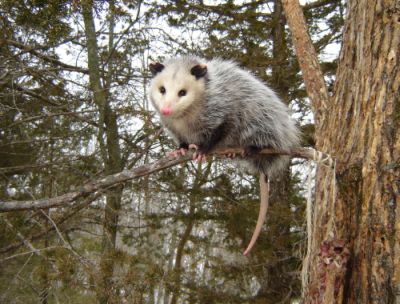See also: North Carolina State Symbols and Official Adoptions main page; Opossums (Encyclopedia of North Carolina); Slow Poke the Possum; Heidi the Cross-Eyed Opossum
Session Law 2013-189, signed June 26, 2013, gave North Carolina the following state symbols: state fossil, state frog, state salamander, state marsupial, state folk art, and state art medium.
Selection as the State Marsupial

The change was proposed under house bill 830 and was sponsored by Representatives Susan Martin, Pat McElraft, Roger West, Jonathan Jordan, Nathan Ramsey and Rena Turner.
About the Virginia Opossum
The Virginia Opossum is the only marsupial native to North America. European explorers first encountered the animal upon their arrival to the Americas. In 1612, early settler John Smith described the Virginia Opossum as having “the head of a pig, the tail of a rat, the size of a cat with baggage under her belly where she carries and suckles her young.” It is currently classified as game and as a fur bearing animal, and is frequently harvested for food, fur, and sport.
The possum is typically 21 to 36 inches long, weighing from four to fifteen pounds. Each of their four feet have five toes. While the first four toes have claws, the fifth functions similarly to a thumb and allows the possum to grab objects. Their fur can range from a light gray to extremely dark. They have fifty teeth, more than any other American Mammal.
Virginia opossums are omnivores and will eat anything available to them, including garbage. They prefer woodlands, but are extremely adaptable and will live in nearly any habitat within their ecological range. They can be found throughout North Carolina, and range from Southern Canada, through much of the United States and Mexico, all the way down to Northern Costa Rica. Possums are good at climbing, swimming, and running. Being primarily nocturnal, they are most active at night and will typically sleep in a den during the day.
The Opossum will have up to two litters a year. One to fifteen babies might be born, though typically only four to seven survive. The young weigh only 0.13 grams when they are born, but by the time they are 100 days old, they will weigh over 130 grams. Young stay in their mother’s pouch for the first 55 days of their life, then will come out for short periods. They travel either in the pouch or on the mother’s back until they are 85 days old. They will eventually leave the mother and live on their own at around 100 days old. Virginia Opossums live 1-2 years on average.

North Carolina Session Law, 2013, c. 189
House Bill 830
Whereas, the Virginia opossum is native to North Carolina and is the only marsupial found in North America; the female carries its underdeveloped young in a pouch until they are capable of living independently, similar to a kangaroo; and
Whereas, the Virginia opossum is one of the oldest and most primitive species of mammal found in North America; and
Whereas, the Virginia opossum is about the size of a large house cat with a triangular head; a long pointed nose; dark eyes; a long, scaly, prehensile tail; and short, black, leathery ears; and
Whereas, the Virginia opossum is nocturnal and lives in a wide variety of habitats, including deciduous forests, open woods, and farmland but prefers wet areas such as marshes, swamps, and streams...
The General Assembly of North Carolina enacts:
SECTION 1. Chapter 145 of the General Statutes is amended by adding the following new sections to read:
"§ 145‑44. State marsupial.
The Virginia opossum (Didelphis virginiana) is adopted as the official marsupial of the State of North Carolina.